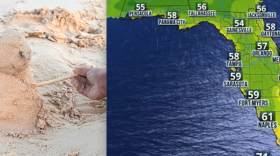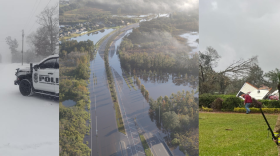Florida Gov. Ron DeSantis stopped in Collier County on Tuesday to announce $3.5 billion in future spending on a variety of environmental protections during his second term.
The billions in taxpayer dollars eclipse the amount DeSantis allotted for Florida’s environment just days after being installed as governor in 2019, which grew to nearly $3 billion and was an amount the Republican governor’s office said was the most in state history.
“Four years ago, I promised to pursue a bold agenda and to commit to lead Florida into a new era of stewardship for Florida’s natural resources, and we delivered,” DeSantis said Tuesday. “I am proud to announce the next step in this administration’s continued dedication to Florida’s treasured environment.”
DeSantis said his order means focused action and the money to pay for it will “continue our momentum and enhance our ongoing efforts to expedite critical Everglades restoration projects (and) employ sound science to protect and restore our waterways.”
Critics of the Republican governor have said he engages in “greenwashing” – making splashy, big-money announcements about support for universally popular environmental challenges in Florida like the Everglades restoration, clean water, and combating harmful algae blooms -- while not doing anything to eliminate the root causes behind global warming by enacting policies to reduce the amount of carbon in the atmosphere and passing laws to ban the burning of fossil fuels.
Before DeSantis was Florida’s governor, he was a three-term congressman representing the Sunshine State in Washington D.C. His positive environmental voting record on Capitol Hill was a mere 2 percent, according the League of Conservation Voters, which is in line with the GOP in general. The league’s state-level coalition, Florida Conservation Voters, backed DeSantis’ Democratic rival for governor in 2018.
But in Collier County announcing the $3.5 billion in new spending on the Sunshine State’s environment he was lauded by top administration officials flanking him.
“Under Governor DeSantis’ leadership and with the support of the Florida Legislature, the state has taken unprecedented steps to effectively address our most pressing environmental issues,” said Shawn Hamilton, secretary of the Florida Department of Environmental Protection. “With this renewed support and direction, Florida’s environment will remain a priority and we will continue to have the resources to bolster our long-term environmental programs and meet the needs of our diverse state.”
Key provisions of DeSantis’ executive order include directing the state DEP to:
- Prioritize the protection of the Indian River Lagoon and secure at least $100 million annually for priority projects to improve water quality there.
- Expand the existing wastewater grant program by broadening project eligibility to address impacts to water quality from sources such as stormwater and agricultural runoff.
- Ensure that all wastewater facilities discharging treated water not up to top water-quality standards upgrade by 2033.
- Coordinate with the Florida Department of Economic Opportunity to improve local government planning to encourage sustainable growth while protecting natural resources.
- Ensure continued funding for efforts to protect residents from the effects of rising seas and a warming planet.
- Expedite the state’s land conservation efforts including buying more land along wildlife corridors.
Other key provisions include:
- Continue with efforts to try and beat deadlines on projects within the Everglades restoration efforts.
- Reduce discharges from Lake Okeechobee into the St. Lucie and Caloosahatchee estuaries and send more, cleaner water south to provide drinking water for 9 million residents and benefit the thirty Everglades ecosystem.
- Continue efforts by the harmful algal bloom task forces.
- Continue the red tide emergency grant program and add to it similar supports from state and local governments when blue-green algae outbreaks occur.
Eric Eikenberg, the CEO of the nonprofit Everglades Foundation, said the new billions while allow for the gains during the last four years to continue and even expand.
“This executive order continues the massive momentum to make sure we are protecting our natural resources not just in Southwest Florida,” he said, “but also in other parts of our state.”
Environmental reporting for WGCU is funded in part by VoLo Foundation, a non-profit with a mission to accelerate change and global impact by supporting science-based climate solutions, enhancing education, and improving health.
Sign up for WGCU's monthly environmental newsletter, the Green Flash, today.
WGCU is your trusted source for news and information in Southwest Florida. We are a nonprofit public service, and your support is more critical than ever. Keep public media strong and donate now. Thank you.









